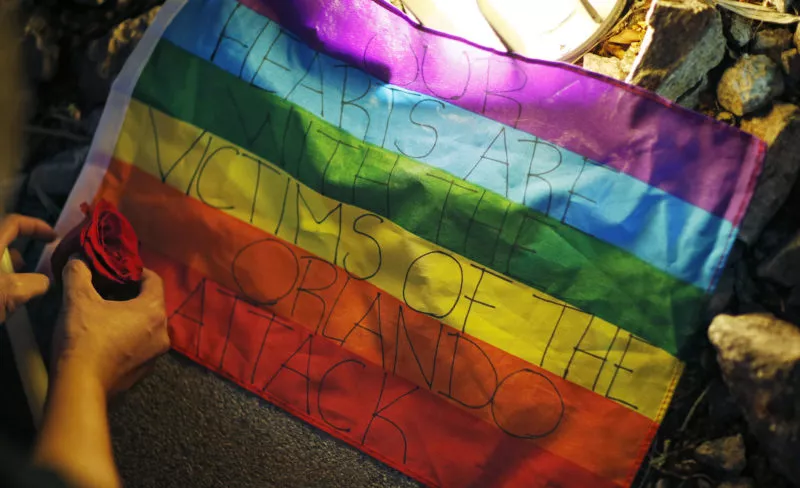 In the wake of the largest mass shooting in U.S. history, it’s inevitable that school kids of all ages will hear snippets of the news and be confused and even afraid. At least 49 people are dead and 53 are wounded after a lone gunman, identified as Omar Sassiqui Mateen, targeted the LGBTQ community when he opened fire at a popular Orlando gay nightclub. The shooting is being investigated as a terror attack and analysis and reactions to the attack are dominating headlines.
In the wake of the largest mass shooting in U.S. history, it’s inevitable that school kids of all ages will hear snippets of the news and be confused and even afraid. At least 49 people are dead and 53 are wounded after a lone gunman, identified as Omar Sassiqui Mateen, targeted the LGBTQ community when he opened fire at a popular Orlando gay nightclub. The shooting is being investigated as a terror attack and analysis and reactions to the attack are dominating headlines.
“Although it’s still early in the investigation, we know enough to say that this was an act of terror and an act of hate,” President Obama said in a statement. “And as Americans, we are united in grief, in outrage, and in resolve to defend our people.”
Mass shootings are no longer rare occurrences and it’s understandable that children will be worried that something might happen to them or to those they love. They will have questions and it’s important that trusted adults like parents and educators address their concerns rather than trying to shelter them.
It’s also important to emphasize that no group of people should be feared because of the act of one person. The responsibility of educators includes battling hate and teaching tolerance and understanding of all people, especially in the aftermath of a horrific attack like the one in Orlando.
“Good people are dead again because of easy hate and easy guns. You cannot build a wall to protect against that. You have to fight it from within and speak the truth, standing up to those to teach hate and those who learn hate,” said NEA President Lily Eskelsen García. “Orlando, we are holding you in love. In a thousand ways, we will turn our powerful love into powerful actions and stand against the hate that was unleashed against you. Hate cannot stand against the love we hold within our universal humanity.”
The National Association of School Psychologists offers the following tips for talking to your students about mass shootings and other national tragedies:
Reassure children that they are safe. Emphasize that schools are very safe. Validate their feelings. Explain that all feelings are okay when a tragedy occurs. Let children talk about their feelings, help put them into perspective, and assist them in expressing these feelings appropriately.
Create time to listen and be available to talk. Let their questions be your guide as to how much information to provide. Be patient. Children and youth do not always talk about their feelings readily. Watch for clues that they may want to talk, such as hovering around while you do the dishes or yard work. Some children prefer writing, playing music, or doing an art project as an outlet. Young children may need concrete activities (such as drawing, looking at picture books, or imaginative play) to help them identify and express their feelings.
Keep your explanations developmentally appropriate.
- Early elementary school children need brief, simple information that should be balanced with reassurances that their school and homes are safe and that adults are there to protect them. Give simple examples of school safety like reminding children about exterior doors being locked, child monitoring efforts on the playground, and emergency drills practiced during the school day.
- Upper elementary and early middle school children will be more vocal in asking questions about whether they truly are safe and what is being done at their school. They may need assistance separating reality from fantasy. Discuss efforts of school and community leaders to provide safe schools.
- Upper middle school and high school students will have strong and varying opinions about the causes of violence in schools and society. They will share concrete suggestions about how to make school safer and how to prevent tragedies in society. Emphasize the role that students have in maintaining safe schools by following school safety guidelines (e.g. not providing building access to strangers, reporting strangers on campus, reporting threats to the school safety made by students or community members, etc.), communicating any personal safety concerns to school administrators, and accessing support for emotional needs.
Review school safety procedures. This should include procedures and safeguards at school and at home. Help children identify at least one adult at school and in the community to whom they go if they feel threatened or at risk.
Observe children’s emotional state. Some children may not express their concerns verbally. Changes in behavior, appetite, and sleep patterns can indicate a child’s level of anxiety or discomfort. In most children, these symptoms will ease with reassurance and time. However, some children may be at risk for more intense reactions. Children who have had a past traumatic experience or personal loss, suffer from depression or other mental illness, or with special needs may be at greater risk for severe reactions than others. Seek the help of mental health professional right away if you are at all concerned.
Limit media exposure. Limit television viewing and be aware if the television is on in common areas. Monitor what kids are viewing online and how they are consuming information about the event through social media. Developmentally inappropriate information can cause anxiety or confusion, particularly in young children. Adults also need to be mindful of the content of conversations that they have with each other in front of children, even teenagers, and limit their exposure to vengeful, hateful, and angry comments that might be misunderstood.
Maintain a normal routine. Keeping to a regular schedule can be reassuring and promote physical health. Ensure that children get plenty of sleep, regular meals, and exercise. Encourage them to keep up with their schoolwork and extracurricular activities but don’t push them if they seem overwhelmed.
A lot of these tips can also be applied to educators — to take proper care of their students, they must first take care of themselves.
For more information, please visit NEA’s School Crisis Guide.


